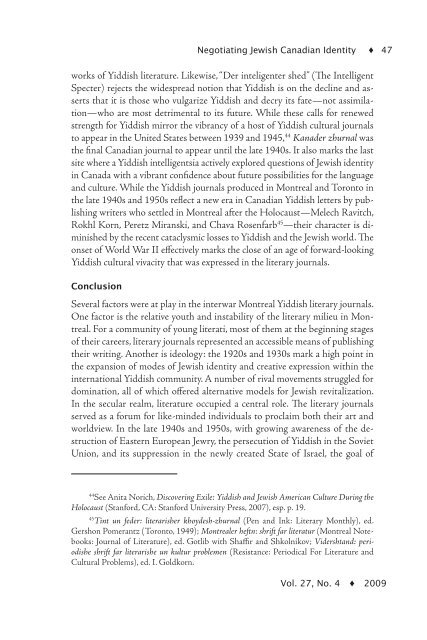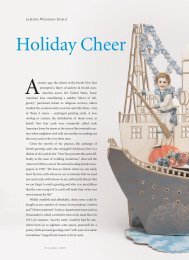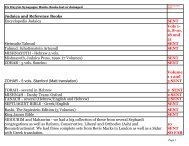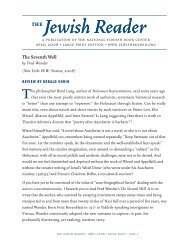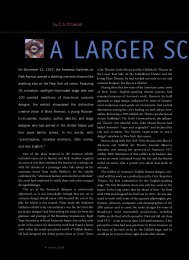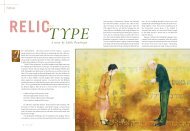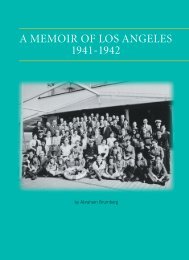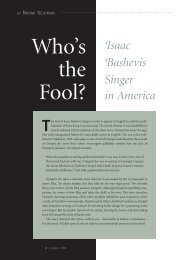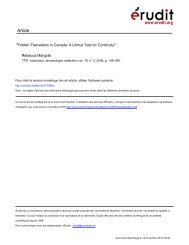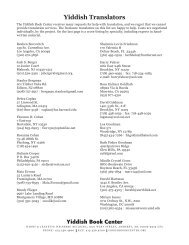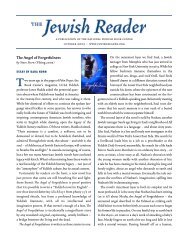Negotiating Jewish Canadian Identity Montreal Yiddish Literary ...
Negotiating Jewish Canadian Identity Montreal Yiddish Literary ...
Negotiating Jewish Canadian Identity Montreal Yiddish Literary ...
You also want an ePaper? Increase the reach of your titles
YUMPU automatically turns print PDFs into web optimized ePapers that Google loves.
<strong>Negotiating</strong> <strong>Jewish</strong> <strong>Canadian</strong> <strong>Identity</strong> ♦ 47works of <strong>Yiddish</strong> literature. Likewise, “Der inteligenter shed” (The IntelligentSpecter) rejects the widespread notion that <strong>Yiddish</strong> is on the decline and assertsthat it is those who vulgarize <strong>Yiddish</strong> and decry its fate—not assimilation—whoare most detrimental to its future. While these calls for renewedstrength for <strong>Yiddish</strong> mirror the vibrancy of a host of <strong>Yiddish</strong> cultural journalsto appear in the United States between 1939 and 1945, 44 Kanader zhurnal wasthe final <strong>Canadian</strong> journal to appear until the late 1940s. It also marks the lastsite where a <strong>Yiddish</strong> intelligentsia actively explored questions of <strong>Jewish</strong> identityin Canada with a vibrant confidence about future possibilities for the languageand culture. While the <strong>Yiddish</strong> journals produced in <strong>Montreal</strong> and Toronto inthe late 1940s and 1950s reflect a new era in <strong>Canadian</strong> <strong>Yiddish</strong> letters by publishingwriters who settled in <strong>Montreal</strong> after the Holocaust—Melech Ravitch,Rokhl Korn, Peretz Miranski, and Chava Rosenfarb 45 —their character is diminishedby the recent cataclysmic losses to <strong>Yiddish</strong> and the <strong>Jewish</strong> world. Theonset of World War II effectively marks the close of an age of forward-looking<strong>Yiddish</strong> cultural vivacity that was expressed in the literary journals.ConclusionSeveral factors were at play in the interwar <strong>Montreal</strong> <strong>Yiddish</strong> literary journals.One factor is the relative youth and instability of the literary milieu in <strong>Montreal</strong>.For a community of young literati, most of them at the beginning stagesof their careers, literary journals represented an accessible means of publishingtheir writing. Another is ideology: the 1920s and 1930s mark a high point inthe expansion of modes of <strong>Jewish</strong> identity and creative expression within theinternational <strong>Yiddish</strong> community. A number of rival movements struggled fordomination, all of which offered alternative models for <strong>Jewish</strong> revitalization.In the secular realm, literature occupied a central role. The literary journalsserved as a forum for like-minded individuals to proclaim both their art andworldview. In the late 1940s and 1950s, with growing awareness of the destructionof Eastern European Jewry, the persecution of <strong>Yiddish</strong> in the SovietUnion, and its suppression in the newly created State of Israel, the goal of44See Anita Norich, Discovering Exile: <strong>Yiddish</strong> and <strong>Jewish</strong> American Culture During theHolocaust (Stanford, CA: Stanford University Press, 2007), esp. p. 19.45Tint un feder: literarisher khoydesh-zhurnal (Pen and Ink: <strong>Literary</strong> Monthly), ed.Gershon Pomerantz (Toronto, 1949); <strong>Montreal</strong>er heftn: shrift far literatur (<strong>Montreal</strong> Notebooks:Journal of Literature), ed. Gotlib with Shaffir and Shkolnikov; Vidershtand: periodisheshrift far literarishe un kultur problemen (Resistance: Periodical For Literature andCultural Problems), ed. I. Goldkorn.Vol. 27, No. 4 ♦ 2009


